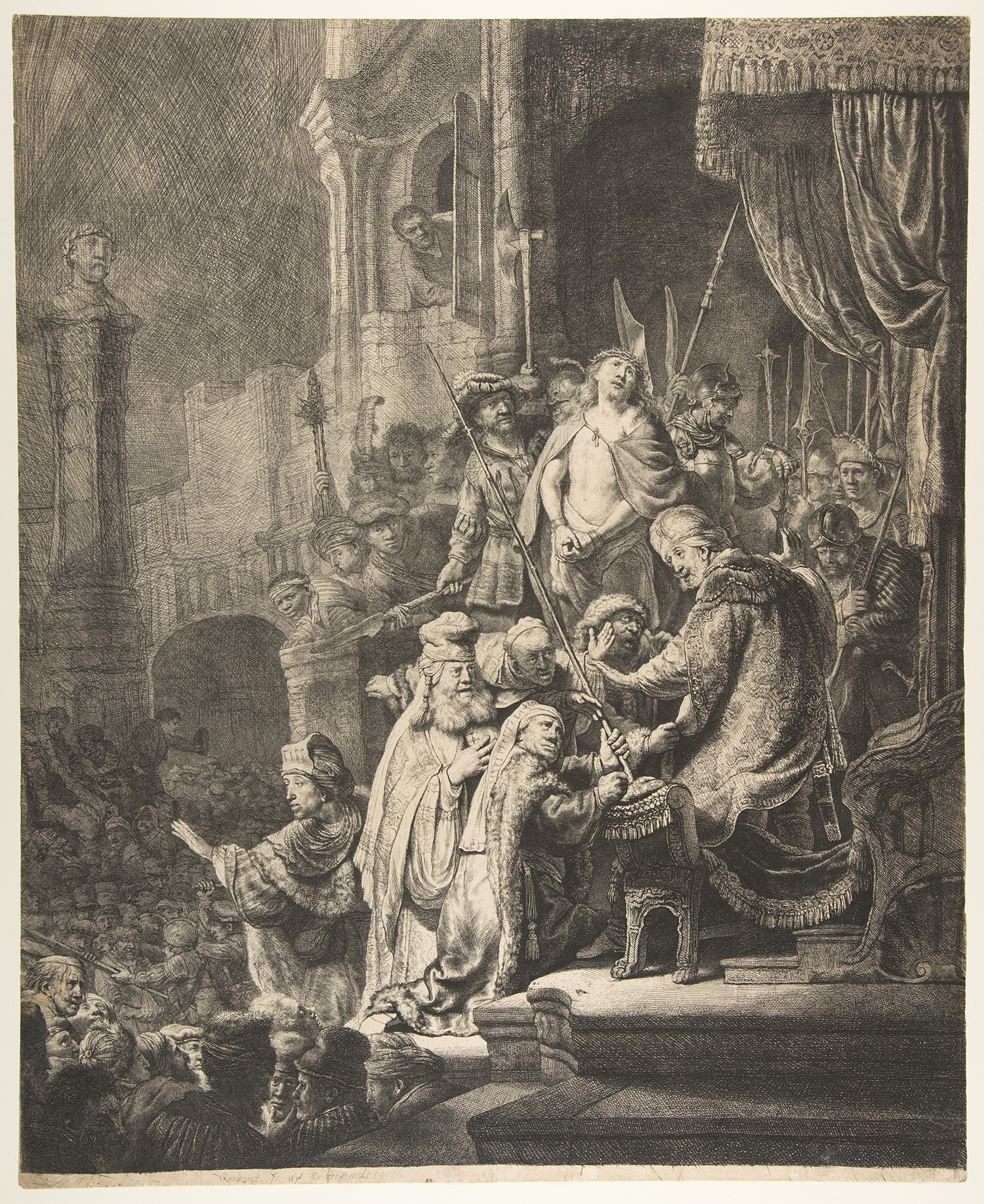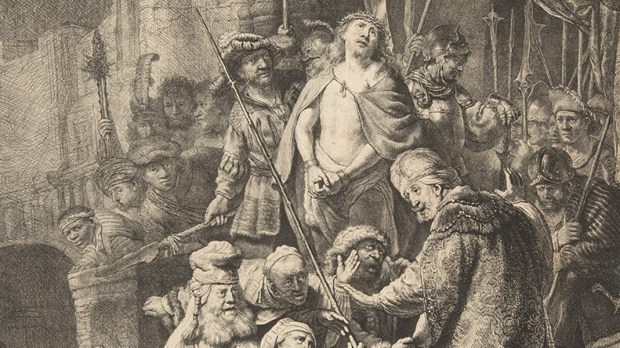The indefinable Rembrandt Van Rijn (1606-1669) has made his mark in history more through his etchings than his paintings. His scratches and scribbles, his bizarre variety of lines from loose to quick, cross-hatched to deep, dark to spotty have succeeded in depicting the world through black and white beauty. Rembrandt’s needle-like quill wove waves of life and creativity. His secret weapon was the dry point technique.
One of the most powerful prints composed by Rembrandt is undoubtedly Christ before Pilate. Rembrandt wiped the ink differently each time he printed, thus creating several renditions of one image. The plural scene is set with limpid fusion and high emotional intensity. Unlike Michelangelo, Rembrandt was not obsessed with the muscular. His style is boundless representing the human being in all ages, statures and conditions. They are subtle and yet complex, detailed and yet bare, grouped and yet isolated. But like the musicians of an orchestra Rembrandt’s drawings form one unique symphony of art.
The lyrics of today’s etching however are piercingly paradoxical. The hailing hosannas have now stifled to the callous “Crucify Him.” The theater in which the tragic scene unfolds is a stone-paved Roman courtyard, teeming with life. To our left we notice an arched gateway through which pours in an amorphous, anonymous assembly displaying various stages of analysis, anticipation and agitation.
The gesticulating crowd is so grand that it does take an effort to disentangle them for their many individualizing gestures. They prowl over each other and climb up the base of the obelisk surmounted by the bust of a Roman emperor in order to bear witness to the spectacle set before them. Soldiers are seen managing the mob with spears even as a young beardless general lifts up his hand in an attempt to pacify the magnifying multitude.
The asymmetrical scene flows into a sharp spiral in the foreground. To our left are gathered a group of political Pharisees and scheming scribes. As they devise their heinous plan of action, a disheartened bearded individual to our extreme left hangs down his powerless head and hopeless heart in shame. Could it be Peter torn between the love for his Master and the fear of being taken to trial?
As the madness of the merciless crowd multiplies, we are invited to mull over a maze of ironies. Let’s begin with the protagonists:
The life and ministry of Christ often tickled the political leaders of the day and sent shivers down their spurious spines. The infancy narratives talk about Augustus, Cyrenius and Herod who trembled at the thought of the birth of a new king and a new order. This confrontation reaches its peak, 30 three years later, as Jesus stands before Pontius Pilate, the local representative of Cesar Augustus.
Rembrandt depicts Pilate as a dignified elderly man seated on a royal throne set under a brilliant baldachin draped with cascading curtains. He is seen deliberating with the Teachers of the Law with regard to the truth. Ironically, the Truth himself stands before the Roman Governor – Christ. the Alpha and the Omega!
Devoid of beauty and desire, the appearance of the Messiah stands in stark contrast to the extravagant robes of the earthly rulers. And yet, the mass of bloodthirsty soldiers mockingly but ironically crown Jesus with thorns and dress Him in a purple robe. In the midst of deafening disgrace, Christ the King lifts His gaze seeking not the approval of men but rather the will of His Father and the establishment of His eternal kingdom.

Pilate, on the other hand, seeks to secure his throne (though temporary) by obliging to the fickle whims of the Pharisees and the ever-changing truth of the masses. Even his royal spear is wielded by the religious leader of the law. A barbarous Barabbas kneels and stares at the Roman governor in anticipation of the important decision.
As throngs of people flood the colonnades and the balconies of the Roman quarters, a young man sporting a feathered hat and a royal scepter draws our attention. It is none but the artist himself! Rembrandt through his etching summons us to a sacred jest, the supreme irony upon which our faith rests.
For here stands a King – weak, fragile, vulnerable, with no political office, no academic degree, no cultural influence and no system of domination. A King whose mission is far from expediency and personal aggrandizement. He is concerned not with the kingship of the world and makes no attempt to save Himself! Rather, Christ the King awaits His throne – the Cross through which would be established the salvation of humankind and the everlasting Kingdom of love.
Finally, the most interesting irony of this episode is the proclamation of the kingship of Christ by none other than the contenders themselves. It featured high up on the Cross in Greek, Latin and Hebrew and reads ‘Jesus of Nazareth, King of the Jews’ (INRI)!
This article first appeared at Indian Catholic Matters and is reprinted here with kind permission.

